|
| |
Effectively Implementing Social Reading Technologies in ESL instructionAnci Cao, Victoria Derevyanskaya, & Silvia Fortuna DiasIntroduction Social reading refers to the activity of reading any type of text collaboratively. It is supported by Vygotsky’s Sociocultural Theory, according to which learning has a social nature and thus occurs through social interaction. From sharing insights to solving problems together, social reading enables ESL learners to engage with instructors and peers in order to understand the intricacies of a new text and collectively construct knowledge. It is in this context that we present Piazza, eComma and NB- three freeware (software that’s available for free) with considerable potential for turning ESL reading into a social activity. Piazza (https://piazza.com/) Piazza has been used worldwide as a Learning Management System (LMS) in various fields. However, this social learning platform can be embedded into your favorite LMS and explored in your ESL class only for social reading purposes. As a social reading tool, Piazza offers three main features: (1) wiki style boards, (2) discussion boards and (3) polls. The wiki-style board allows the instructor to give students access to the reading materials in three ways: (a) copying and pasting, (b) adding a hyperlink (for texts from online sources) and (c) uploading a file. Additionally, students can benefit from its toolbar to copy and paste definitions as well as add hyperlinks, pictures, and videos (Figure 1) in order to create vocabulary and cultural information logs collaboratively. Figure 1  The discussion board has a similar layout to the wiki-style board. It enables instructors and students to share comments as well as ask and answer questions anonymously or by identifying themselves - a confidence-builder feature for those who are too shy or afraid to participate. Once someone resolves a question or comment, it takes one click on the resolved button (see arrow in Figure 2) for the student who posed the question to be notified by email. This feature may increase students’ motivation to go back to Piazza. Figure 2 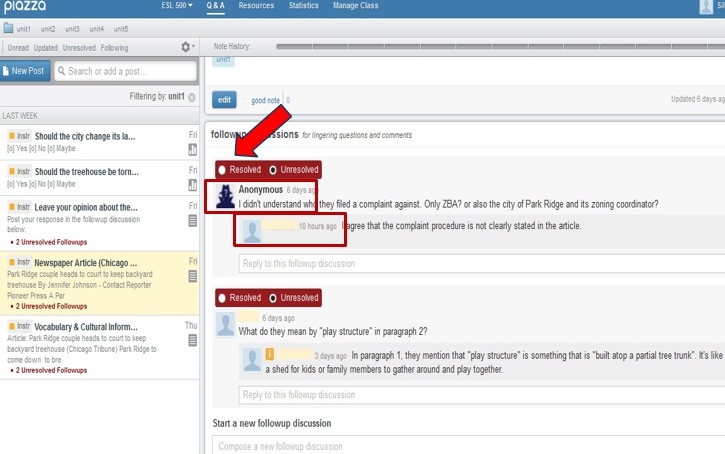 The poll may be used as a pre- or post-reading activity. If done before class, it may help students test and summarize their text comprehension; if done in class, it may assist them with reactivation of the text gist. The instructor can set up votes to be cast anonymously (Figure 3) or by showing voters’ names. The instructor may also choose to open the poll results in class in order to generate class discussion. As examples of activities, if votes are anonymous, a general discussion can be conducted; whereas, if voters’ names are shown, the instructor can have each student share with others the reasons for voting for a particular option. Figure 3  Among various advantages, Piazza facilitates text comprehension, vocabulary learning and cultural understanding. Opportunities for language-specific discussions and content-related exchanges promote critical thinking as students are enabled to go beyond the text level and ultimately make connections with the real world. For assessment, teachers can count on three features that track students’ participation: (a) a graph of the group participation per week (Figure 4), (b) a list of top student contributors with number of contributions and days online, and (c) an individual participation report with number of days online, posts viewed and contributions (Figure 5). Figure 4 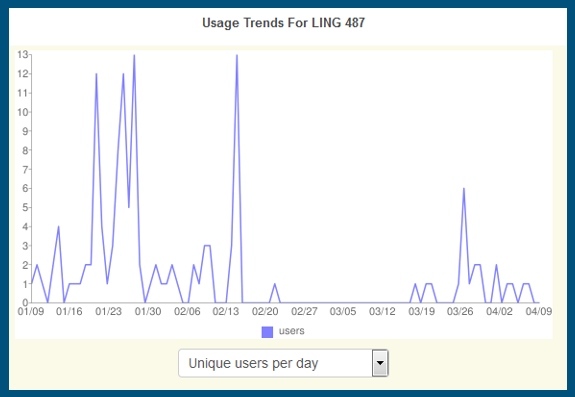 Figure 5 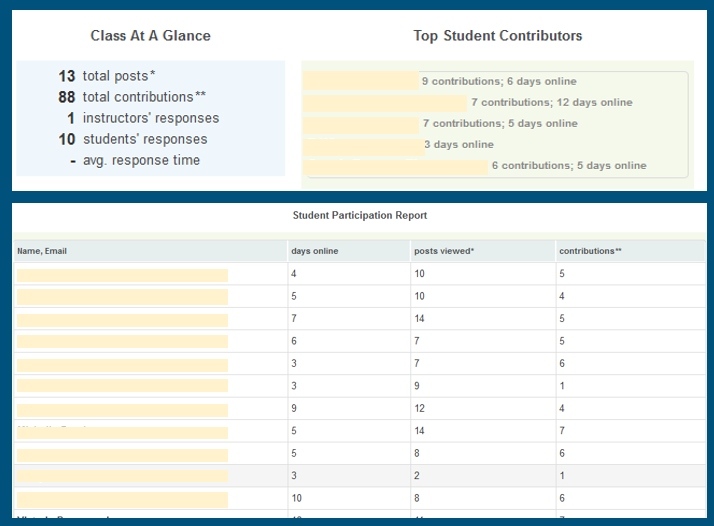 eComma (https://coerll.utexas.edu/ecomma/) eComma is another tool for social reading that allows students to annotate texts collaboratively, ask and answer questions about content and vocabulary, and highlight grammatical aspects. The social reading tool has three main features that aid text comprehension and enable students to interact with each other while reading: (1) text's word cloud, (2) commenting function, and (3) tagging function. eComma can be embedded into an LMS or can be used independently. The text can be copied and pasted into eComma. However, no PDF files can be downloaded into the management system. Word Cloud is a unique feature of the software which distinguishes it from the other reading tools. It is a visual display of words from a text with the bigger words being the most frequent words in the text (Figure 6). Word Cloud can be used as a pre-reading activity to activate students’ background knowledge by discussing what the text is about just looking at the word cloud. It can also be used to facilitate contextualized vocabulary acquisition - clicking on the word, students can see how the word is used in context, discuss the meaning of the word, and make their own sentences with this word. Figure 6  To comment on a text, students should highlight any part of a text, and a field will appear in which a comment can be left (Figure 7). This feature provides students with opportunities for critical discussion of the text - students can comment on peer questions, agree or disagree with a particular idea, connect reading to their personal experiences, etc. The interactions that students have with the text and with each other about the text lead to a deeper understanding of the text. The feature also benefits the instructor with the ability to see where students need more help with the text, in order to better address those problems in class. Figure 7 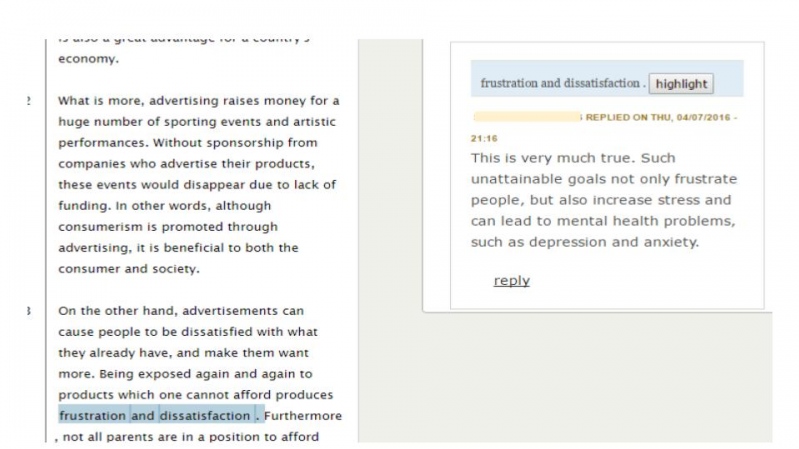 Tagging is another feature of eComma that promotes noticing of target forms and facilitates vocabulary and grammar acquisition. For ESL learners, tags can be used to identify and label grammatical features, tag unknown words and write definitions of those words in the commentary, and analyze the structure of the text by tagging topic sentences and supporting details etc. Figure 8  Students should sign in before commenting on a text so that the instructor can trace the learners’ comments and annotations. Clicking on the user name will take the instructor to a list of all the students’ comments and tags for the current text. This function helps to monitor students’ activity. Lastly, eComma allows the instructor to download all the comments as an XML file and also to import the comments to a Google docs spreadsheet. NB (http://nb.mit.edu/welcome) The last social reading platform is NB. It is a stand-alone platform that cannot be embedded into other LMSs. As a social reading tool, NB allows you to collaboratively annotate reading materials, share comments, and discuss questions. The following features provided by the platform promote learning opportunities for students both inside and outside ESL classes: (a) clear reference to texts, (b) categorized threads, and (c) downloadable annotated texts. NB allows you to upload and annotate PDF documents. Similar to other common reading/editing tools (e.g. Adobe Reader, MS Word), all the comments and notes are listed on the margin and refer to specific words or parts of the text. Once a thread is selected, the referred parts in the text will be highlighted (Figure 9). This clear reference allows students and teachers to understand exactly what they are discussing. Additionally, the function of providing clear reference fosters different types of discussions. Students can discuss not only content-related (e.g. background/cultural knowledge of the texts, questions/opinions about certain statements, etc.) but also language-related topics (e.g. definition/usage of specific words/phrases). Figure 9 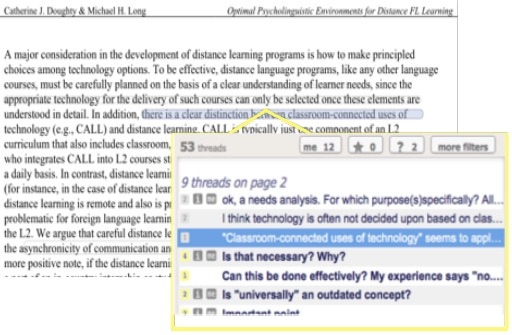 NB enables you to select and view different types of threads in two ways: (1) indicated teacher notes/comments and (2) filtered threads. All comments/notes created by instructors are indicated with an instructor icon (Figure 10). This allows students to easily find out what instructors posted, so that they can complete tasks or clear confusions in a timely manner. In addition, users can utilize the filter to view the threads based on their needs. For instance, instructors can select five threads “that have the most student participation”. This helps instructors understand the most popular issues about the texts, which can be beneficial for better teaching preparation. Figure 10 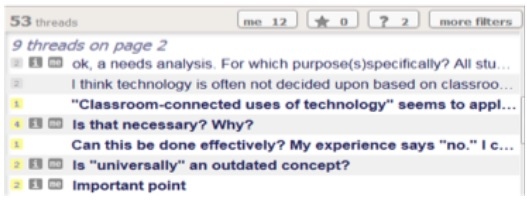 Finally, you are allowed to view, download, and print entire annotated texts through NB (Figure 11). All threads are linked with the highlighted referred contents. Thus, the online discussions can be continued in the classrooms, using annotated texts. Figure 11  Conclusion With similarities and differences in features, each social reading platform discussed in this article can serve a unique purpose in the ESL classroom. Regardless of which one is chosen, implementation requires that students be given some training in order to ensure that their attention remains on the assigned task and not diverted into figuring out how to use these tools and their various features. Also, it is important to organize participation so that each student can experience a wide range of roles (e.g. moderators, question posers, problem solvers) and to ensure that participation rates between highly-motivated students and their shy counterparts can be more balanced. Finally, Piazza, eComma and NB seem to be in alignment with the following Principles of Teaching with Technology (UIC IT Governance Council): (a) promote active learning, (b) empower students, and (c) reflect on teaching practices. In summary, students are constantly engaging with materials, instructors, and other students as they alternate between the roles of expert and novice in order to accomplish specific goals. With such collaborative scaffolding, confidence builds up; students feel empowered and encouraged to take responsibility for their own learning. The instructors, on the other hand, can use the data generated by these tools to inform their practice and tailor their classes according to students’ needs. _______________________ Anci Cao earned her M.A/TESOL at UIC, and she investigated how to use technology to enhance teaching and learning. Victoria Derevyanskaya is a graduate student in the MA/TESOL program at UIC and was also a Fulbright scholar teaching Russian to undergraduate students at DePauw University. Silvia Fortuna Dias is a graduate student in UIC MA/TESOL, after having taught EFL in Brazil for over 10 years, and Portuguese in Chicago. | |
| ITBE Link - Spring 2017 - Volume 45 Number 1 |